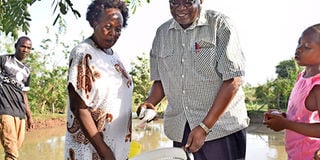She sniffed the money in fish

Martline and her husband, Paul Waindi in their fish farm in Kisumu. According to her, fish farming is not labour-intensive, unlike other livestock ventures. PHOTO | ELIZABETH OJINA | NATION MEDIA GROUP
What you need to know:
- She spent Sh50,000 from her savings to construct two ponds measuring 30m by 10m.
- She feeds the fish twice, at 10am and 4pm with commercial feeds that she buys at Kibuye market at Sh2,000 for a 20kg bag.
- The second season stock of 3,000 tilapia fingerlings earned her over Sh80,000, says Martline, who gets up to 1,000 fish per harvest.
- Safina Musa, the station coordinator at Kenya Marine and Fisheries Research Institute in Kisii, says water used for pond farming should have a high level of dissolved oxygen and be free of silt
In the quiet Buoye village on the outskirts of Kisumu town sits Waindi Farm. The farm, which occupies 2.5 acres, has three earthen ponds that host 4,000 tilapia fish.
Martline Waindi, the owner of the farm, says her passion for fish farming started some eight years ago, when ponds were not a common sight in the region where people are used to fish from Lake Victoria.
“I ventured into fish farming under the Economic Stimulus Programme, three years after my retirement. The project was funded by the government, among other partners," says Martline, who was trained by officials from the programme.
She spent Sh50,000 from her savings to construct two ponds measuring 30m by 10m.
She then applied lime in the ponds to have a stable pH of 5-7, which is conducive for fish farming.
“Before stocking the pond, we made sure we fertilised it with manure to ensure the fingerlings would have natural food," says Martline, who keeps monosex fish for higher yields. She started with 1,000 fingerlings bought at Sh5 each, growing the farm to the current status.
She feeds the fish twice, at 10am and 4pm with commercial feeds that she buys at Kibuye market at Sh2,000 for a 20kg bag.
“Tilapia fingerlings feed mainly on tiny water organisms as well as dead organic matter and as they increase in size, they become entirely herbivorous and feed on small water plants,” she offers, adding that the fish is a surface water feeder that feeds mostly during the day.
Martline also uses chicken droppings from her 35 kienyeji birds as an alternative feed.
“I normally spread polythene material below the poultry house, collect the droppings, dry them and give them to the fish. I also use dried cow dung from the dairy unit to feed the fish. The cow dung keeps predators such as snakes at bay,” says the mother of two, who worked with the Ministry of Water as a secretary.
EXPENSIVE FEEDS
She sells the fish after eight months, with the price ranging from Sh100 to Sh250 each, depending on the size. “From my first harvest, I got over Sh67,000, which is what encouraged me to continue with the venture,” she says.
The second season stock of 3,000 tilapia fingerlings earned her over Sh80,000, says Martline, who gets up to 1,000 fish per harvest.

The farmer sells the fish after eight months, with the price ranging from Sh100 to Sh250 each, depending on the size. PHORO | ELIZABETH OJINA | NATION MEDIA GROUP
According to her, fish farming is not labour-intensive, unlike other livestock ventures.
“The only challenge is the expensive feeds, which are hardly available,” says the farmer, who stocks the ponds at various intervals to ensure she has a steady supply of fish.
Predators and unreliable water is another challenge the farm faces.
“Initially, we had birds, frogs and monitor lizards attacking the fish. The birds would eat the fish as early as 2am when the moon is full. We set up predator’s nets,” says Martline. The quality of water from the nearby river has also become a challenge due to environmental pollution.
“We are in the process of digging a borehole to provide water we are sure of,” she says.
Safina Musa, the station coordinator at Kenya Marine and Fisheries Research Institute in Kisii, says water used for pond farming should have a high level of dissolved oxygen and be free of silt.
“Apart from rivers and streams, farmers can use harvested rainwater and borehole water. The problem with borehole water is that it can have low dissolved oxygen. Therefore, it is advisable to expose it to open air to increase the oxygen level before using it,” says Musa, adding that it is advisable to test the water quality.




